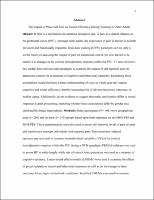Please use this identifier to cite or link to this item:
https://hdl.handle.net/20.500.12202/8344| Title: | The Impact of Perceived Pain on Neural Efficiency During Walking in Older Adults |
| Authors: | Holtzer, Roee Foley, Frederick Seng, Elizabeth Darwazah, Hannah |
| Keywords: | clinical psychology psychology aging |
| Issue Date: | 2022 |
| Publisher: | Yeshiva University |
| Citation: | Darwazah, H. (2022). The Impact of Perceived Pain on Neural Efficiency During Walking in Older Adults (Publication No. 29261565) [Doctoral dissertation, Yeshiva University]. PQDT |
| Series/Report no.: | Ferkauf Doctoral Dissertations;Publication No. 29261565 |
| Abstract: | Objective: Pain is a mechanism for attention disruption due, in part, to a shared reliance on the prefrontal cortex (PFC). Amongst older adults, the experience of pain is known to be both prevalent and functionally impactful. Dual-task walking (DTW) paradigms are not only a useful means of assessing the impact of pain on attentional control, but also known to be sensitive to changes in the cortical hemodynamic response within the PFC. To date, however, few studies have utilized such paradigms to examine the impact of self-reported pain on attentional control via assessment of cognitive and behavioral outcomes. Examining these associations would facilitate a better understanding of ways in which pain may impact cognitive and neural efficiency, thereby increasing risk of adverse functional outcomes, in healthy aging. Additionally, given evidence to suggest that males and females differ in neural responses to pain processing, exploring whether these associations differ by gender may yield useful clinical implications. Methods: Study participants (N= 408) were grouped into pain (n= 266) and no pain (n= 142) groups based upon their responses on the MOS-PSS and MOS-PES. These questionnaires were also used to assess self-reported levels of pain severity and interference amongst individuals with reported pain. Functional near-infrared spectroscopy was used to measure intraindividual variability (IIV) of the cortical hemodynamic response within the PFC during a DTW paradigm. PKMAS software was used to assess IIV in stride length, while rate of correct letter generation was used as a measure of cognitive accuracy. Linear mixed effects models (LMEMs) were used to examine the effects of perceived pain on neural and behavioral responses as well as on the change in these outcomes form single- to dual-task conditions. Stratified LMEMs were used to examine whether these associations differed by gender. Results: LMEMs revealed that perceived pain presence was associated with reduced IIV in PFC oxygenation and reduced IIV in stride length in the DTW condition. High pain severity was associated with a greater increase in stride length IIV from STW to DTW. Stratified LMEMs revealed that the association between pain and neural IIV was significant in only males, while the associations between pain and gait IIV were significant in only females. Potential Implications: Study results suggest that self-reported pain over one month is associated with differential patterns of neural and behavioral responding amongst healthy, community-dwelling older adults. In this population, these patterns may reflect a tendency towards inefficient neural and behavioral modifications in response to perceived pain. These findings highlight the need for clinical use of routine pain assessments and, when appropriate, the implementation of timely and effective pain treatments in aging. |
| Description: | Doctoral dissertation, PhD / YU only |
| URI: | https://hdl.handle.net/20.500.12202/8344 https://ezproxy.yu.edu/login?url=https://www.proquest.com/dissertations-theses/impact-perceived-pain-on-neural-efficiency-during/docview/2697676017/se-2?accountid=15178 |
| ISBN: | 9798837528705 |
| Appears in Collections: | Ferkauf Graduate School of Psychology: Doctoral Dissertations |
Files in This Item:
| File | Description | Size | Format | |
|---|---|---|---|---|
| Darwazah Hannah YU only Dissertation_HD_Final 2022.pdf | 518.96 kB | Adobe PDF |  View/Open |
This item is licensed under a Creative Commons License

